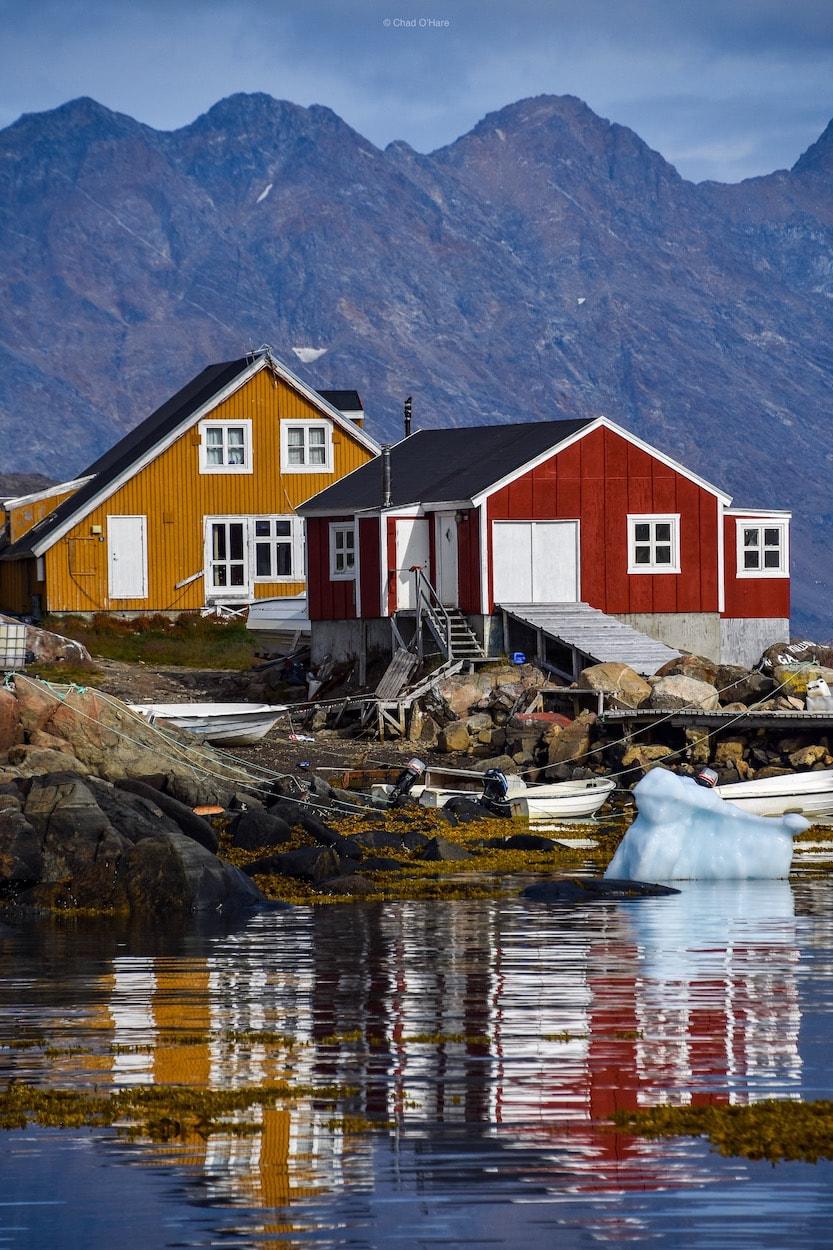|
Helping you decide where to go in Greenland: East or West.
West Greenland offers a powerhouse of sights, delivering the travellers’ much-sought-after wow factor. Ilulissat’s Icefjord pumps out ten percent of Greenland’s calf ice with colosseum-sized icebergs. Disko Island serves up basalt columns, sheer cliffs and moss-laden valleys. Glacier Lodge Eqi indulges visitors with the feeling of remoteness from the accessibility of a tourist-packed ferry; run daily during summer months. For those seeking more of an escape, days without spotting another tourist and minimal infrastructure, East Greenland answers your quest. Greenland is certainly more diverse than implied by the squiggly white expanse that appears on Google Maps. Only a narrow band of coastline is habitable because ice covers the majority of the country. The ice shield reaches up to 3,200 metres deep and covers an area of over 1.8 million square kilometres. The country’s population is less than sixty-thousand citizens. Traditional red, blue and yellow buildings mingle among houses painted in contemporary tones of fuchsia and lime green. At one time, colours signified something about its inhabitants. Danish families often painted their homes red while fish factories were blue and medical centres brushed yellow. Such scenes turn striking when set against a backdrop of behemoth icebergs. Shards of ice stretch skyward with blocks made rough from calved chunks and melted ridges. Boats connect towns across Greenland—or in winter months, dog sleds. There are no roads between settlements. For this reason, I was surprised to see the number of vehicles driven in towns. They would have to be shipped from Denmark and would be used solely within a five-kilometre radius, to loop back and forth along a handful of streets connecting a handful of buildings. Likewise, most goods are imported from Denmark. Even the smallest of towns had a supermarket with freshly-baked grain bread, cinnamon or custard pastries and an impressive assortment of cheese, be it Havarti, Parmesan, Brie—double cream or truffle infused—or simply Danish blue. My favourite café in Ilulissat, Cafennguaq, served fresh dishes by cheerful locals. It seemed to be the busiest restaurant in town, not only with tourists but equally with residents and exemplified how tourism can benefit a community without ruining the spirit of a place. On the surface, villages in Greenland’s secluded east region looked surprisingly similar to those on the opposite side of the country’s ice sheet. Most towns are home to less than three-hundred people. Colourful houses cluster near the water’s edge. Every family keeps a team of dogs and at least one sledge, often more in varying sizes. In August, these sleds could be seen stored above sheds, tucked onto a balcony or stacked on a makeshift rack along with an assortment of fishing gear, old tangled nets or a weathered buoy. Skulls of musk oxen hung above doorways while the vertebrae of whales decorated yards. Beyond these similarities, a divergent mood stalked my thoughts of Greenland’s east region compared to its more-visited western front. Many homes lacked running water. Few hotels existed. Ferries were nonexistent. Conversely, towns across western Greenland supported comfortable hotels, bustling fisheries of halibut and shrimp, often restaurants and some level of ferry service. Visitors who do not want to see West Greenland from a package cruise ship could opt for kayak, water taxi, Disko Line’s localized ferries or Arctic Umiaq’s larger coastal service. West Greenland is the region most visitors see, even Conan O’Brien chose Disko Bay to base his latest Conan Without Borders episode after Trump’s infamous Tweet offering to buy Greenland. East Greenland sees far fewer visitors. Livelihoods are based around hunting—fish, seal and reindeer primarily. Those tour companies that do operate here gravitate towards Icelandic, Danish or other foreign staff except for boat drivers who tend to be from the local communities. You may ask, “What is East Greenland really like?” For me, it lacked the wow factor of the west, but exuded it’s own charm. I can best explain it by sharing my own experience. The East I walked for four days, mostly following a fjord crammed with icebergs. On the first day before the monuments of ice had come into view, I noticed a grey expanse looming in the distance. It was not a low-hanging cloud, but my initial glimpse of Greenland’s massive ice sheet. In person, it felt daunting to see the edge of this ancient mass. The Sermilik Icefjord sliced the space between the ice cap and me. I had heard of this channel, but its name resonated only after I saw it for myself. Tabular icebergs floated like private warehouses amid ridged wedges and crowns of ice the size of palaces. Occasional crashes rang from the congested fjord. Echoes confirmed another iceberg had flipped or fractured. Determining which one remained a mystery. You would think such a sizeable shift would be easy to spot. You would be wrong. The crowded waterway obscured puffs of ice and foaming water behind neighbouring icebergs. Rings of waves eventually emerged to give away the approximate location, but by this time the iceberg in question had settled and floated innocently atop black waters. Only by my third morning did I catch an iceberg in the act of flipping. From beneath the water, spiky points and striated panels quickly transformed from a submerged base to become the next iconic masterpiece among its iceberg peers. Sermilik’s metropolis of ice dominated the landscape. Beyond two towns where I started and ended, the only other sign of human settlement was on a rocky peninsula where a couple of abandoned huts stood next to a cross. Long grass sprouted from the grave. Our guide was from France and it was his first summer working in Greenland. Unfortunately, I was unable to learn the story behind these huts. I wished people from the community where we had started or ended the trek could have joined us to share their knowledge. We climbed no more than a few hundred metres each day. The land alternated between uneven bog and granite hills. For about seven hours every day, lumpy piles of thick grass and chunky rocks guided my feet. Occasionally, I switched to water shoes to cross a river. Any blister or achy spot soon turned numb. My knees cursed the hard rocks along the final day’s trail to Tiniteqilaaq. I passed one lady carrying a bucket of clean drinking water collected from the town’s communal tap and a few sledging dogs who barely glanced my way. It was a Sunday and the store had closed a few hours earlier meaning there was little to bring people outdoors. It seemed an anticlimactic end to the trek. Soon enough, my group of eleven including our guide settled into the rhythmic surges of a speedboat that transported us back to our starting point, the village of Kulusuk. There is one store in Kulusuk. The young man working as a cashier may not have spoken much English, but he handed over the still-warm cinnamon scroll with a smile and did not seemed to mind that we used a credit card to pay for such a meagre purchase. After finishing our snack, my husband and I wandered to the harbour’s shoreline. A brother and sister, probably less than six years old, poked at squid-like fish swimming in the tidal pools. They giggled when one of the creatures jumped a little quicker than they expected and did not seem to notice or mind us strangers standing nearby. We were also staring at the water, but were captivated instead by a stranded iceberg and the various fishermen that headed out or returned from the inlet. We were all doing what we do. Children played. Locals fished. Foreigners watched. At that moment, we all felt part of that little community, In fact, the word Inuit simply means “people”. For travellers curious about far-off cultures and diverse landscapes, Greenland offers layers of unforgettable moments and warm smiles. The only choice is whether to visit the vibrant west or less-trodden eastern region. Either way, this unique land is bound to linger in your thoughts long after you leave its shore. More stories and travel tips can be found in my latest book Searching for Unique.
1 Comment
Millie
9/3/2019 07:13:45 pm
Very much enjoyed your prospective on Greenland. It is a lonely place & this contributes to its intrigue .The locals are faced with daily hardship that they must take in their stride, much to be admired.
Reply
Leave a Reply. |










 RSS Feed
RSS Feed